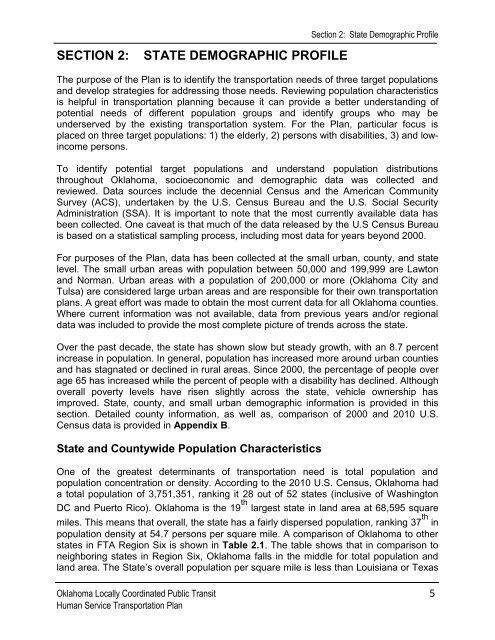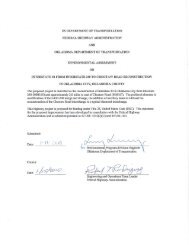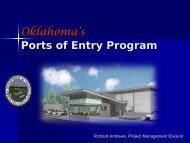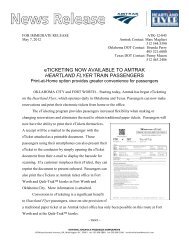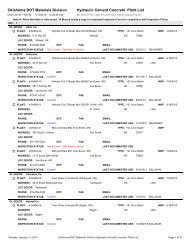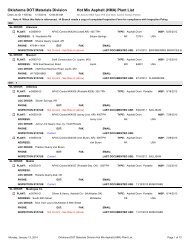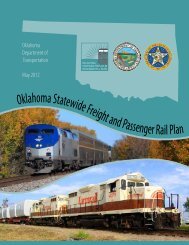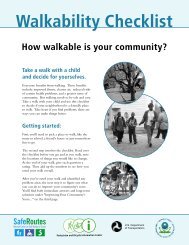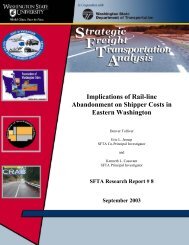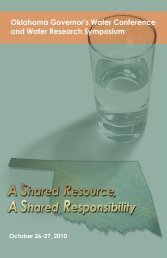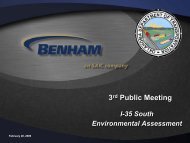JARC Coordination Plan - Oklahoma Department of Transportation
JARC Coordination Plan - Oklahoma Department of Transportation
JARC Coordination Plan - Oklahoma Department of Transportation
Create successful ePaper yourself
Turn your PDF publications into a flip-book with our unique Google optimized e-Paper software.
Section 2: State Demographic Pr<strong>of</strong>ile<br />
SECTION 2:<br />
STATE DEMOGRAPHIC PROFILE<br />
The purpose <strong>of</strong> the <strong>Plan</strong> is to identify the transportation needs <strong>of</strong> three target populations<br />
and develop strategies for addressing those needs. Reviewing population characteristics<br />
is helpful in transportation planning because it can provide a better understanding <strong>of</strong><br />
potential needs <strong>of</strong> different population groups and identify groups who may be<br />
underserved by the existing transportation system. For the <strong>Plan</strong>, particular focus is<br />
placed on three target populations: 1) the elderly, 2) persons with disabilities, 3) and lowincome<br />
persons.<br />
To identify potential target populations and understand population distributions<br />
throughout <strong>Oklahoma</strong>, socioeconomic and demographic data was collected and<br />
reviewed. Data sources include the decennial Census and the American Community<br />
Survey (ACS), undertaken by the U.S. Census Bureau and the U.S. Social Security<br />
Administration (SSA). It is important to note that the most currently available data has<br />
been collected. One caveat is that much <strong>of</strong> the data released by the U.S Census Bureau<br />
is based on a statistical sampling process, including most data for years beyond 2000.<br />
For purposes <strong>of</strong> the <strong>Plan</strong>, data has been collected at the small urban, county, and state<br />
level. The small urban areas with population between 50,000 and 199,999 are Lawton<br />
and Norman. Urban areas with a population <strong>of</strong> 200,000 or more (<strong>Oklahoma</strong> City and<br />
Tulsa) are considered large urban areas and are responsible for their own transportation<br />
plans. A great effort was made to obtain the most current data for all <strong>Oklahoma</strong> counties.<br />
Where current information was not available, data from previous years and/or regional<br />
data was included to provide the most complete picture <strong>of</strong> trends across the state.<br />
Over the past decade, the state has shown slow but steady growth, with an 8.7 percent<br />
increase in population. In general, population has increased more around urban counties<br />
and has stagnated or declined in rural areas. Since 2000, the percentage <strong>of</strong> people over<br />
age 65 has increased while the percent <strong>of</strong> people with a disability has declined. Although<br />
overall poverty levels have risen slightly across the state, vehicle ownership has<br />
improved. State, county, and small urban demographic information is provided in this<br />
section. Detailed county information, as well as, comparison <strong>of</strong> 2000 and 2010 U.S.<br />
Census data is provided in Appendix B.<br />
State and Countywide Population Characteristics<br />
One <strong>of</strong> the greatest determinants <strong>of</strong> transportation need is total population and<br />
population concentration or density. According to the 2010 U.S. Census, <strong>Oklahoma</strong> had<br />
a total population <strong>of</strong> 3,751,351, ranking it 28 out <strong>of</strong> 52 states (inclusive <strong>of</strong> Washington<br />
DC and Puerto Rico). <strong>Oklahoma</strong> is the 19 th largest state in land area at 68,595 square<br />
miles. This means that overall, the state has a fairly dispersed population, ranking 37 th in<br />
population density at 54.7 persons per square mile. A comparison <strong>of</strong> <strong>Oklahoma</strong> to other<br />
states in FTA Region Six is shown in Table 2.1. The table shows that in comparison to<br />
neighboring states in Region Six, <strong>Oklahoma</strong> falls in the middle for total population and<br />
land area. The State’s overall population per square mile is less than Louisiana or Texas<br />
<strong>Oklahoma</strong> Locally Coordinated Public Transit 5<br />
Human Service <strong>Transportation</strong> <strong>Plan</strong>


